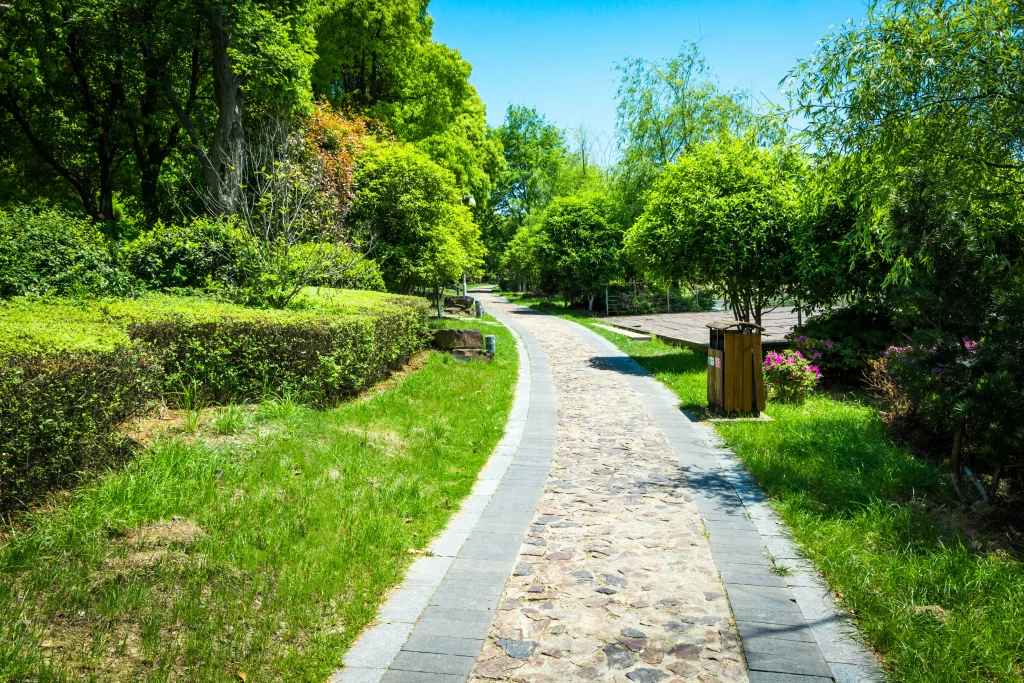A well-edged lawn transforms your property with clean, defined borders that separate grass from driveways, sidewalks, and garden beds. However, Denver’s challenging soil composition demands specific techniques and timing to create professional-looking edges that withstand Colorado’s distinct seasonal changes.
This comprehensive guide covers the essential elements of lawn edging: selecting appropriate tools, learning how to edge a lawn step by step, determining optimal timing, and maintaining your edges throughout the season.
Whether you’re establishing new edges or refreshing existing ones, these Denver-specific strategies will help you create and maintain pristine lawn borders despite our tough soil conditions.
Tools You’ll Need to Edge a Lawn Properly
Selecting the right edging tools depends on your lawn size, border materials, and personal comfort. Here’s what works best in Denver’s challenging soil conditions:
Manual Tools
- Half-moon edger: Creates precise edges in smaller spaces. The curved blade cuts cleanly through Denver’s clay soil when properly sharpened.
- Spade or flat shovel: Penetrates tougher Denver soil effectively. The straight edge delivers clean cuts when soil moisture levels are appropriate.
- Hand shears or grass clippers: Provides detail work around obstacles and hard-to-reach areas, perfect for fine-tuning after your main edging is complete.
Power Tools
- String trimmer with edging guide: Offers speed but sacrifices some precision. Works well for maintenance but can struggle with initial cuts in dense Colorado clay.
- Electric or gas-powered lawn edger: Delivers clean vertical cuts, especially valuable for creating straight lines along sidewalks and driveways. The added power helps penetrate Denver’s compacted soil.
- Rotary edging blade attachment: Compatible with many trimmers and particularly effective for refreshing existing edges in our tough soil conditions.
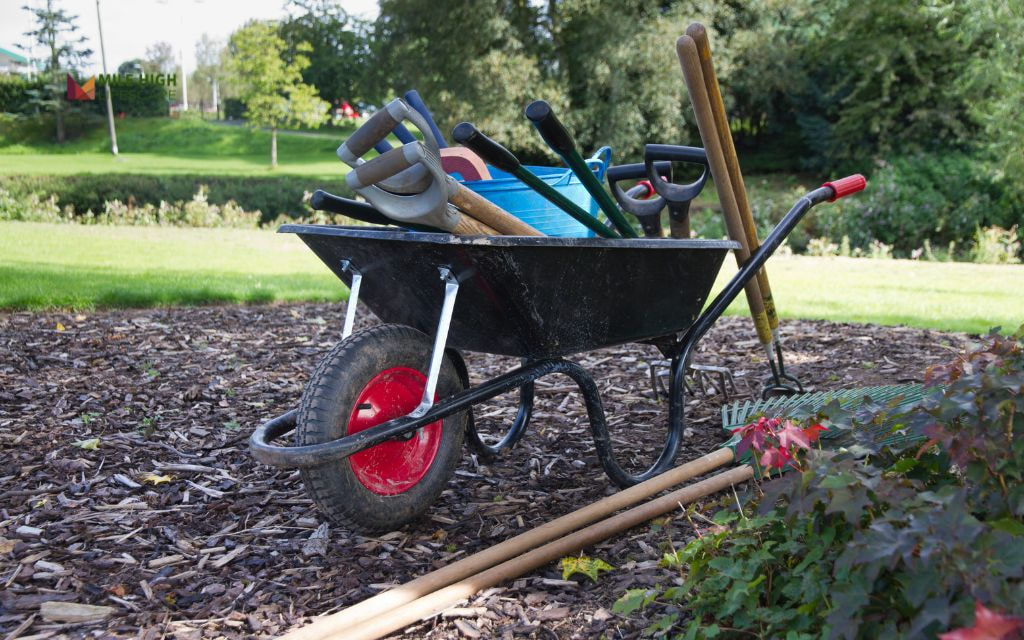
How to Edge a Lawn: Step-by-Step Guide
Creating clean, defined edges in Denver’s challenging soil requires a methodical approach. Follow these steps for professional-looking results whether you’re edging from scratch or maintaining existing borders:
- Step 1: Mark your edge path – Use a garden hose, string, or marking paint to outline your desired edge. For curved edges, a hose works best to visualize the natural flow before cutting.
- Step 2: Water the soil properly – Dampen the ground 12-24 hours before edging. This critical step softens Denver’s compact clay soil without creating mud. Aim for moist but not soggy conditions—if soil sticks to your tools in clumps, it’s too wet.
- Step 3: Position your tool correctly – Hold your edger vertically against the marked line. For power tools, ensure the blade faces the correct direction (usually with the open side toward the lawn).
- Step 4: Cut your trench – Push the edging tool into the soil about 2 inches deep. Work in 1-2 foot sections, maintaining consistent depth. For Denver’s clay soil, use a rocking motion rather than forcing the tool through in one push.
- Step 5: Create a clean line – Pull the tool toward you slightly after pushing down to create a clean cut. With power tools, move slowly and steadily along your marked line.
- Step 6: Remove excess material – Clear soil, grass, and roots from the trench using a hand trowel or small rake. In clay soil, this material often comes out in chunks—collect these for use in other garden areas or compost.
- Step 7: Shape the edge – Define your edge according to your preference. For formal landscapes, maintain vertical walls. For natural areas, create a slight slope (about 15 degrees) which helps prevent edge collapse in our freeze-thaw cycles.
- Step 8: Inspect your work – Step back periodically to view your progress from different angles. Look for consistent depth and clean lines, making adjustments as needed.
- Step 9: Remove all debris – Rake or blow soil and grass clippings away from walkways and back into the lawn. For debris in garden beds, incorporate it into the soil or remove it completely.
- Step 10: Final touch – Water the newly edged area lightly to help settle the soil and create a finished appearance. This also reduces stress on grass plants along the new edge.
Following these detailed steps ensures your lawn edges will look professional and withstand Denver’s challenging climate conditions. For best results, maintain consistent depth and clean lines throughout the process.
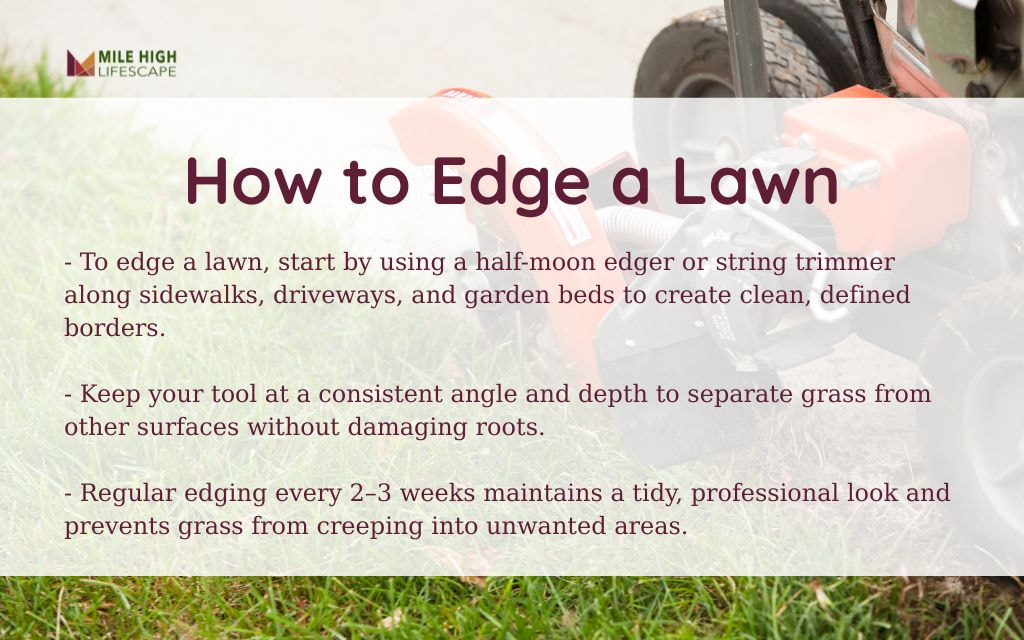
Techniques for Different Lawn Edge Styles
Learning how to edge a lawn properly includes selecting the right style for your property. Denver landscapes benefit from various edging styles that complement different architectural and landscape designs.
The right edge style not only enhances your lawn’s appearance but also serves practical functions in our unique climate.
Natural Edge
This classic approach creates a clean, defined border without physical barriers between lawn and beds. To achieve this style, cut vertically into the turf, removing excess grass to create a distinct separation.
Natural edges require more frequent maintenance but offer a seamless visual transition that works beautifully with informal garden designs.
In Denver’s clay soil, maintain a depth of 2-3 inches for stability.
Hard Edge
Incorporating metal, brick, concrete, or stone barriers reinforces the border and creates lasting definition. When installing hard edges in Denver, place materials at least 1-2 inches below mowing height to prevent damage from lawn equipment.
Choose materials rated for freeze-thaw conditions to prevent heaving and shifting during our extreme temperature fluctuations. Metal edging should be properly anchored every 3-4 feet for stability in our soil.
Mulch or Gravel Transition
This style establishes a buffer zone between lawn and planting beds using a strip of mulch or decorative gravel.
In Denver’s arid climate, this approach helps with moisture retention and reduces watering needs. Create a trench 4-6 inches wide and 2 inches deep, then fill with your chosen material.
This method effectively prevents grass from invading garden beds while creating visual interest.
With over 20 years of landscaping experience in Denver, Mile High Lifescape offers mulch installation services tailored to Colorado’s distinct environmental needs. Although DIY mulching may appear easy, having it done by professionals guarantees you enjoy all the advantages that proper mulching can bring to your Colorado landscape.
Recessed Edge
Setting the border slightly lower than surrounding areas creates a small trench that contains mulch and prevents grass spread. This style performs exceptionally well with Denver’s heavy spring rains and summer downpours by channeling water away from structures.
Dig the recess 1-2 inches deeper than your typical edging cut, creating a miniature swale that directs water flow while defining your landscape elements.

When Is the Best Time to Edge a Lawn in Denver?
Timing your lawn edging in Denver’s unique climate can make the task significantly easier and more effective. Our clay-heavy soil presents different challenges throughout the year, so strategic timing is essential.
Spring (March-May)
Optimal Window: Late April to early May
Why it works: Spring is ideal for establishing new edges or rejuvenating winter-damaged borders for several reasons:
- Soil moisture is typically higher from spring precipitation
- Ground has thawed but isn’t baked hard by summer heat
- Allows you to establish clean edges before rapid growth season
- Easier to spot and correct damage from winter snow removal
Denver Tip: Wait until after the last frost (typically mid-May) for installing new physical edging materials to prevent frost heave damage.
Fall (September-October)
Optimal Window: Late September to mid-October
Why it works: Fall edging prepares your lawn for winter and gives you a head start next spring:
- Cooler temperatures make physical work more comfortable
- Soil typically has good moisture balance after summer irrigation
- Growth has slowed, so edges stay crisp longer
- Clean edges help prevent winter lawn diseases common in Denver
Denver Tip: Fall is an excellent time to add physical edging materials as they’ll have time to settle before freeze-thaw cycles begin.
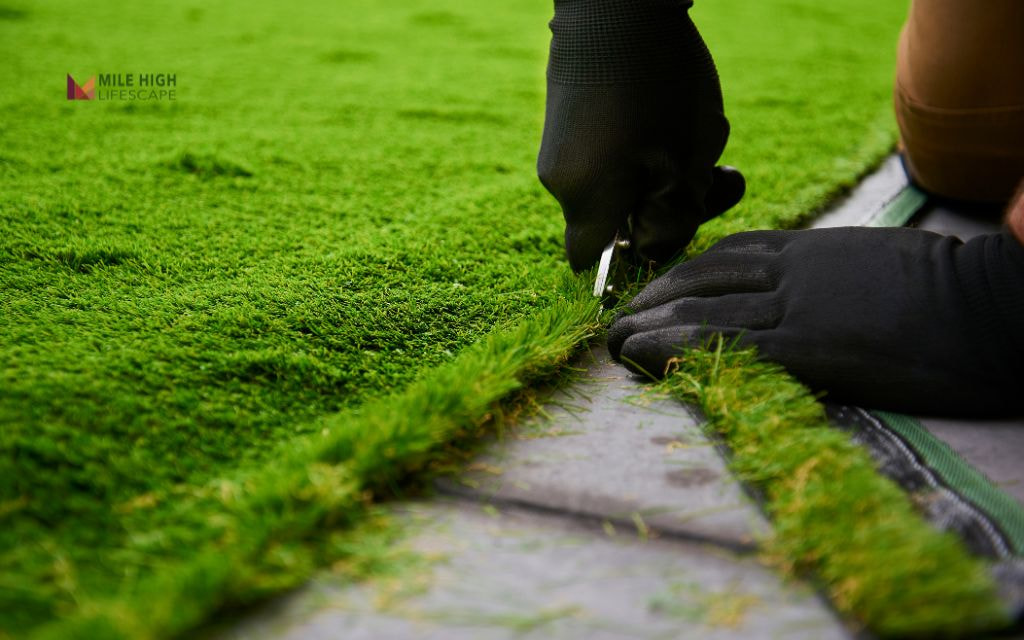
Times to Avoid Edging in Denver
- Mid-summer (June-August): Denver’s clay soil becomes extremely hard and difficult to cut during hot, dry periods
- During drought conditions: Stressed lawns with dry soil are vulnerable to additional damage from edging
- Winter (December-February): Frozen ground is nearly impossible to edge properly and can damage tools
- Immediately after heavy rain: Saturated clay soil can be messy and compacts easily when worked
How To Maintain Lawn Edging Long-Lasting
Once you’ve learned how to edge a lawn properly, establish a consistent maintenance routine. With proper routine care, you can keep your edges crisp with minimal effort and avoid having to start from scratch each year.
Essential Maintenance Schedule for Denver
- Every 2-3 Weeks (Growing Season: May-September): Use a string trimmer in the vertical position to quickly touch up the edges during regular mowing. This frequent light maintenance prevents grass from reclaiming the edge.
- Inspect Monthly: Inspect physical edging materials for shifting caused by Denver’s expanding/contracting soils and re-secure as needed. Check for weed growth in edging trenches and remove promptly.
- Recut Twice Per Season: Use a manual or power edger to recut edges that have started to degrade. This deeper maintenance keeps the definition sharp and prevents major lawn encroachment.
- Seasonal Refreshing: Plan for a complete edge refreshing in both spring and fall. Knowing how to edge a lawn seasonally helps maintain definition year-round. Spring edging defines spaces after winter dormancy, while fall edging creates clean lines that persist through winter.
Quick Maintenance Tips for Busy Denver Homeowners
- Combine with mowing: Always edge after mowing, when you can clearly see the lawn’s boundaries and grass height is consistent
- Irrigation check: Adjust sprinkler heads near edges to prevent excessive water that encourages grass creep
- Mulch refresh: Add new mulch to beds in spring to highlight the clean edges and suppress weeds
- Weed control: Apply targeted herbicides in edging trenches – Denver’s alkaline soil creates favorable conditions for certain stubborn weeds
- Winter prep: Clean edges thoroughly before winter to prevent snow mold and ice damage along borders
- Tool maintenance: Sharpen edging tools regularly – Denver’s rocky soil quickly dulls blades
Common Mistakes to Avoid When Edging a Lawn
Even experienced Denver landscapers can make errors when edging lawns. Avoiding these common pitfalls will save you time, protect your lawn, and ensure professional-looking results.
- Edging too deep: Cutting beyond 2-3 inches damages grass roots and creates unstable edges prone to collapse. Denver’s soil structure particularly suffers from overly aggressive cutting.
- Using dull tools: Dull blades tear rather than cut, creating jagged edges and requiring significantly more physical effort—especially problematic in our clay soil.
- Skipping proper watering: Attempting to edge bone-dry Denver soil leads to frustration, tool damage, and poor results. Always moisten soil appropriately beforehand.
- Neglecting regular maintenance: Allowing edges to deteriorate for extended periods creates much more work when you finally address them. Our climate’s freeze-thaw cycles accelerate edge deterioration when maintenance lapses.
- Creating overly complex designs: Intricate patterns require substantial maintenance. Denver’s soil conditions favor simpler, cleaner edge designs that remain stable through seasonal changes.
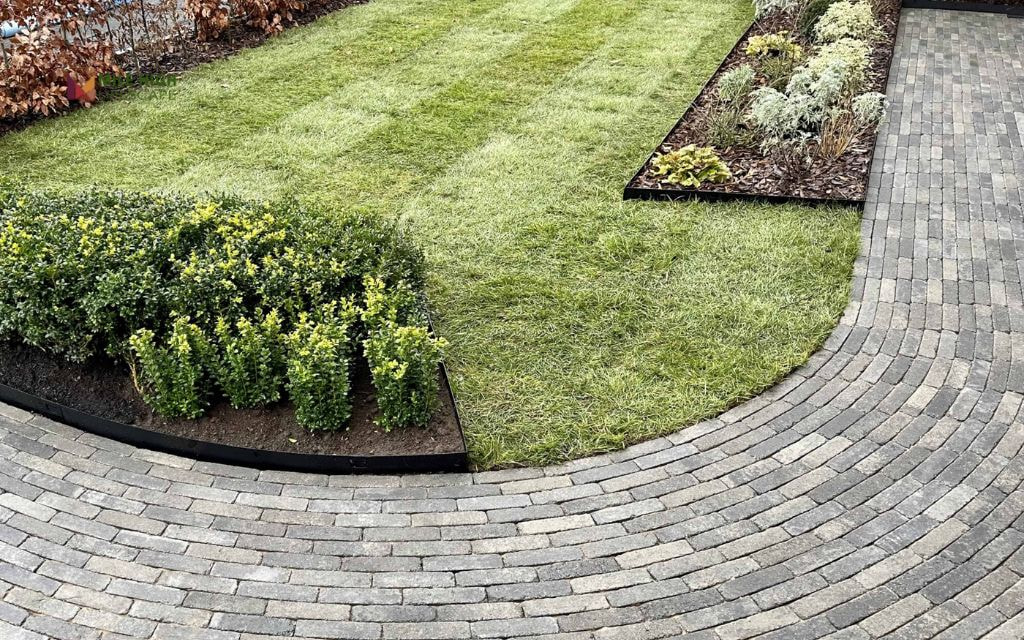
When to Hire a Lawn Care Professional for Edging
While many Denver homeowners successfully tackle lawn edging themselves, there are situations when hiring a professional landscape service like Mile High Lifescape makes practical and financial sense.
Professional edging services include specialized equipment, regional expertise, and efficient techniques that can save time and ensure quality results.
Hiring experts makes sense when:
- Your property includes extensive footage of borders requiring edging
- Your landscape incorporates significant elevation changes or retaining walls
- You lack proper tools or physical capacity for the task
- You desire perfectly manicured edges throughout the season
Mile High Lifescape offers comprehensive lawn edging services tailored specifically to Denver’s unique conditions. Our team understands the local soil challenges and seasonal considerations, delivering precise, long-lasting edges that enhance your property’s appearance.
Conclusion
Understanding how to edge a lawn properly transforms your Denver landscape with clean, defined borders that elevate your property’s appearance. While our region’s clay-heavy soil presents challenges, the right tools, techniques, and timing effectively overcome these obstacles.
The knowledge you’ve gained equips you to create professional-looking edges that require less maintenance over time. Well-defined borders prevent grass invasion into beds and hardscapes while improving irrigation efficiency – practical benefits beyond the visual enhancement.
Whether you apply these techniques yourself or recognize when professional help would benefit your landscape, Mile High Lifescape offers specialized services tailored to Denver’s unique conditions.
Contact us at (303) 877-9091 or request a free quote through our website for personalized lawn edging solutions.
Frequently asked questions (FAQs)
What is the easiest way to edge a lawn?
Pre-moistening the soil 12-24 hours before edging significantly reduces effort. For established lawns, a power edger delivers the best combination of speed and results in our challenging soil.
Should I edge before or after mowing?
Edge before mowing to avoid cleanup twice. The mower will collect much of the debris created during edging, saving you time.
How often should Denver homeowners refresh their lawn edges?
Complete re-edging typically occurs twice yearly (spring and fall), with light maintenance every 2-3 weeks during peak growing season.
What do professionals use for edging in Denver?
Professional landscapers typically use commercial-grade power edgers with hardened steel blades specifically designed to cut through our dense clay soil efficiently.
Is garden edging worth it?
Absolutely. Beyond aesthetics, proper edging reduces maintenance by preventing grass from invading beds and walkways. In Denver’s climate, it also helps manage water runoff and erosion during our intense summer thunderstorms.
